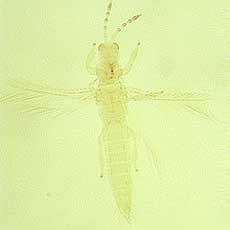| Biology |
| This
species is a serious pest of cucurbits and many other plants in countries
throughout the moist tropics, both from direct feeding damage and from
the transmission of tospoviruses. |
 |
| Distribution |
| Originally
from South East Asia, this species is now widespread throughout the wet
tropics. Both its distribution, and the size of its populations, appear
to be severely limited by weather conditions. Large populations develop
under hot and humid conditions, but heavy rain as well as low temperatures
and also aridity are all conditions under which the species does not
thrive. |
| Recognition |
Female
macropterous; body and legs yellow, major setae light brown; antennal
segments IV & V brown distally, VI & VII brown; forewings pale.
Antennae 7-segmented, III & IV slightly constricted at apex with
short forked sense cone; VII short. Head wider than long, with 2 pairs
of ocellar setae; pair III small and arising just outside the ocellar
triangle; postocular setae pair I slightly longer than ocellar setae
III. Pronotum with 2 pairs of long posteroangular setae, posterior margin
with 3 pairs of setae. Metanotum with irregular longitudinal lines converging
to posterior margin, with curving transverse lines at anterior; median
setae arising behind anterior margin, campaniform sensilla present. Mesofurca
with spinula. Forewing first vein with 3 (or 2) setae on distal half,
second vein with row of about 15 setae. Tergite II with 4 lateral marginal
setae; V–VIII with ctenidia present laterally, on VIII posteromesad
to spiracles; posterior margin of VIII with complete comb of long slender
microtrichia; pleurotergites without discal setae. Sternite II with 2
pairs of marginal setae, III–VII with 3 pairs, the median pair
on VII arising in front of margin; sternites without discal setae.
Male similar to female but smaller; tergite VIII with marginal comb complete
medially; sternites III–VII with narrow transverse glandular area. |
| Related
species |
|
| Thrips
palmi is most readily confused with the widespread Old World species
Thrips flavus, but has the ocellar setae III posterolateral to the fore
ocellus and outside the ocellar triangle, instead of posterior to this
ocellus and within the ocellar triangle.
|
